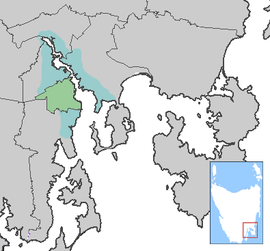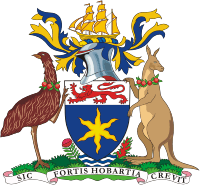Hobart City
| City of Hobart Tasmania | |||||||||||||
|---|---|---|---|---|---|---|---|---|---|---|---|---|---|
 The City of Hobart (green) and Greater Hobart (teal) | |||||||||||||
 Flag of the City of Hobart | |||||||||||||
| Coordinates | 42°52′48″S 147°17′24″E / 42.88000°S 147.29000°ECoordinates: 42°52′48″S 147°17′24″E / 42.88000°S 147.29000°E | ||||||||||||
| Population | 50,714 (2015 Est)[1] | ||||||||||||
| • Density | 651/km2 (1,690/sq mi) | ||||||||||||
| Established | 1852[2] | ||||||||||||
| Area | 77.9 km2 (30.1 sq mi) | ||||||||||||
| Mayor | Sue Hickey | ||||||||||||
| Council seat | Hobart | ||||||||||||
| Region | Central Hobart | ||||||||||||
| State electorate(s) | Denison | ||||||||||||
| Federal Division(s) | Denison | ||||||||||||
 | |||||||||||||
| Website | City of Hobart | ||||||||||||
| |||||||||||||

The City of Hobart is a local government area of Tasmania, Australia. It is one of five local government areas covering the metropolitan area of the state capital, Hobart but covers only a small section of the city's 200,000 population. With 48,703 people[3] it is the third most populated council in Tasmania. The present municipal council was created in 1852 by act of parliament, and the city mayor raised to Lord Mayor in 1934.[4]
Government

The City of Hobart is governed by the Hobart City Council, consisting of twelve aldermen headed by the Lord Mayor of Hobart. The present Lord Mayor is Sue Hickey. Aldermen are elected every four years.
| Name | Position[5] | Party affiliation | |
|---|---|---|---|
| Sue Hickey | Lord Mayor/Alderman | Independent | |
| Ron Christie | Deputy Lord Mayor/Alderman | Independent | |
| Marti Zucco | Alderman | Independent | |
| Jeff Briscoe | Alderman | Independent | |
| Eva Ruzicka | Alderman | Independent | |
| Peter Sexton | Alderman | Independent | |
| Helen Burnet | Alderman | Greens Party | |
| Phillip Cocker | Alderman | Greens Party | |
| Damon Thomas | Alderman | Independent | |
| Suzy Cooper | Alderman | Independent | |
| Anna Reynolds | Alderman | Greens Party | |
| Tanya Denison | Alderman | Independent | |
Economy
The Hobart City Council estimates that on weekdays "close to 50% of the population of Greater Hobart would be in the City for working, shopping, education, personal business or leisure purposes".[6]
Major industries by employment:[6]
- Health and Community Services 17%
- Retail Trade 13%
- Property and Business Services 12%
- Government Administration 12%
- Education 9%
The City has five major hospitals and fire, police, and emergency service headquarters.[6]
Environment
Mount Wellington and the River Derwent are major features of the natural environment of the City of Hobart. 61% of the area is bushland.[6]
Sister cities
References
- ↑ "3218.0 – Regional Population Growth, Australia, 2014–15". Australian Bureau of Statistics. Retrieved 29 September 2016.
- ↑ Hobart City Council
- ↑ Australian Bureau of Statistics (31 October 2012). "Hobart (C) (LGA)". 2011 Census QuickStats. Retrieved 2012-09-10.
- ↑ "About Council". hobartcity.com.au. Hobart City Council. Retrieved 1 February 2015.
- ↑ "Alderman - Hobart City". hobartcity.com.au. Hobart City Council. Retrieved 1 February 2015.
- 1 2 3 4 Draft City of Hobart Planning Scheme 2009, Hobart City Council
- 1 2 Sister Cities. City of Hobart (2006). Retrieved on 24 December 2006.